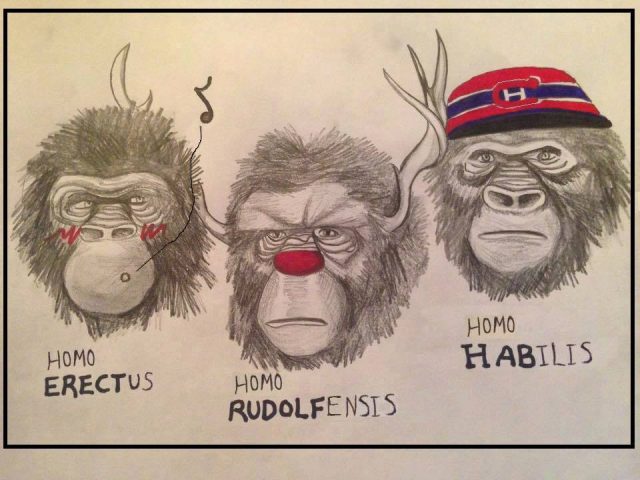Updated September 20.
Even a journey of fifty thousand miles starts with a single step. For early humans, this pioneering first step out of Africa began a globe-spanning journey that would forever change life on Earth. However, aside from the location of this fateful first step, little else is known for certain about our early human roots, and there is much yet to be discovered.
For instance, one source of conflict within the archaeological community is the question of who actually took this first step and when it was taken. It is known that Homo erectus, an extinct species of hominid – a family including all modern and extinct great apes, including modern humans – left Africa about two million years ago and went on to inhabit much of Europe and Asia. However, it is unclear whether these upright walkers were actually the ancestors of Homo sapiens, or humans as we are today.
The debate over early migration
One theory, known as the multiregional hypothesis, suggests that the descendants of these Homo erectus are indeed modern humans, and that the species evolved on multiple continents in a relatively uniform fashion. This model is based on the idea that separate Homo erectus populations established across Eurasia and Africa were in close enough proximity to allow for interbreeding and gene flow. As they evolved, they did so as a relatively cohesive unit despite their spatial separation. According to this theory, regional differences in climate and other factors created the variation in features we observe in the human population.
However, as new genetic and archaeological evidence continues to be discovered, the multiregional hypothesis is not as well-supported as the Out of Africa theory. The latter asserts that Homo sapiens evolved solely in Africa from Homo heidelbergensis, a descendant of Homo erectus. Then, around 200,000 years ago, they left Africa, replacing their hominid relatives that had already settled across Eurasia. However, given surfacing DNA evidence, the term “absorption” may describe the disappearances of these species better than “replacement.” The genes of early hominids such as Neanderthals (Homo neanderthalensis), a species that evolved from Homo heidelbergensis in Europe, compose a small percentage of the genomes of modern people living outside of Africa, indicating that there was likely interbreeding between humans and other hominid species.
Aside from the location of this fateful first step, little else is known for certain about our early human roots, and there is much yet to be discovered.
There are a couple of possible reasons for why Neanderthals, who possessed a similar brain size to modern humans and were in fact capable of complex speech, were replaced by modern humans. “Neanderthals had the intellectual capacity to develop greater complexity, but they had the disadvantage of living in an inhibiting environment,” McGill anthropology professor Michael Bisson told The Daily in an interview. The cold environments Neanderthals inhabited enforced living in small group sizes and high levels of social dispersion; thus, they were not required to develop the social institutions associated with higher-level group interactions. Moreover, the spread of technological innovations amongst Neanderthal communities would have been difficult because populations were so dispersed.
Although popular culture focuses heavily on Neanderthals as the main symbol of human evolution, there are actually a number of other, less well-known variants of archaic humans. The dominance of Neanderthals in the media is in large part due to their early discovery. “Between 1908 and 1922, an abundance of Neanderthal fossils were found in France, helping to cement their place as the prototypical ‘cave men’ in the public mind,” Bisson said. As the first to be found, Neanderthals became the centre of public debates about evolution.
However, the spread of humans into the Americas is not as well-documented in archaeological records as the spread of Neanderthals, as Europe possesses far better conditions for preservation of remains. It has long been believed that humans crossed the land bridge connecting Asia and North America at the end of the last ice age, going on to inhabit both North and South America – though scientists do not agree on this either. There is a discrepancy in possible time periods for this migration, with some scientists asserting circa 15,000 BCE and others circa 30,000 BCE as the likely date of bridging. “We really don’t know exactly what was going on, because now, everything’s underwater,” said Bisson.
Recent discoveries of early human species
Of the Denisovans, one of the recently discovered early hominids, all that has been found is a finger bone and two teeth. Found in the Denisova Cave in Siberia, the Denisovans lived around 41,000 BCE and represent a variant of hominid with DNA distinct from both Neanderthals and modern humans. “They could have been East Asia’s temporal equivalent of Neanderthals,” suggested Bisson.
Whether recent archaeological discoveries such as the Denisovans represent new species is the subject of hot debate within the scientific community. According to Bisson, the research community is comprised of “splitters” and “lumpers.” “‘Splitters’ recognize a greater number of species and ‘lumpers’ argue that there are fewer species and greater variation within species.”
“We’re extremely, perhaps disturbingly, successful.”
So what differences constitute a different species? “That is a judgement call,” Bisson explained. “There is no set number of base pair differences that defines a separate species.”
At an excavation site in Dmanisi, Georgia, a skull determined to be roughly 1.8 million years old was unearthed with four other skulls, all showing tremendous variation. It was originally suggested that the skulls belonged to multiple species. However, because they came from the same location and general geological time – within a 20,000-year period – it’s also possible and even likely that they represent a population of a single species. This discovery suggests that three of the major defined branches of hominids – Homo habilis, Homo rudolfensis, and Homo erectus – could represent a single species.
Regardless of our modelling and classification systems, of course, the way in which humans evolved across time and throughout the globe will remain unchanged. All that will change is our understanding of our beginnings. After leaving Africa, whether it was 200,000 or 1.8 million years ago, we proceeded to inhabit the entire planet and create a global network of advanced societies. “We’re extremely, perhaps disturbingly, successful,” Bisson commented.
“Humans are going to be an interesting experiment. Can behavioural flexibility and intelligence compensate for the fact that we’re rushing towards an overpopulated Earth and exhaustion of terrestrial resources?” Bisson asked. Only time can tell. But perhaps, when we finally have an understanding of where we came from, we will have a clearer sense of where we will go, and how we can continue to survive.
Ha-ha-hominids: A McGill Daily science cartoon!


